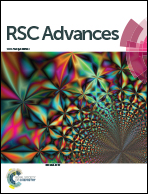Isolation and characterization of copper(iii) trifluoromethyl complexes and reactivity studies of aerobic trifluoromethylation of arylboronic acids†
Abstract
The isolation, characterization and reactivity of transition metal trifluoromethyl complexes are fundamental and challenging topics in trifluoromethylation chemistry. We report herein the synthesis and isolation of two new complexes [(phen)CuI(PPh3)2]+[CuIII(CF3)4]− (2) and (phen)CuIII(CF3)3 (3) as well as a known complex (bpy)CuIII(CF3)3 (4) at room temperature. 2 and 3 have been fully characterized using 1H, 19F, 31P NMR, elemental analyses and X-ray crystallography. Reactivity studies indicate that 2 is unreactive toward arylboronic acids. In contrast, 3 and 4 can react with various aryl and heteroaryl boronic acids to deliver trifluoromethylated arenes in good to quantitative yields under mild conditions. The presence of a fluoride additive in DMF under aerobic conditions is crucial to these reactions. This study provides fundamental information about the structure and reactivity of elusive Cu(III) trifluoromethyl complexes that have been proposed as relevant reactive intermediates in many trifluoromethylation reactions.


 Please wait while we load your content...
Please wait while we load your content...